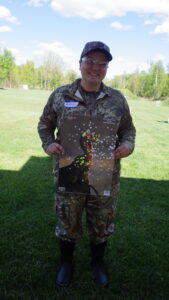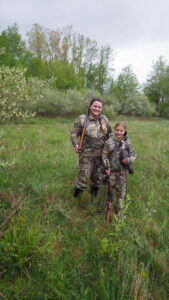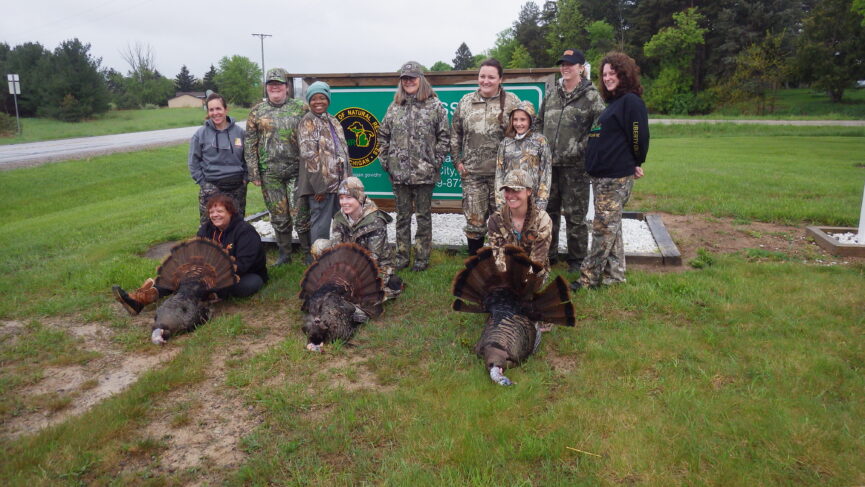
Walking into the Cass City DNR Field Office at 4:30 am just prior to going turkey hunting is always a delight for me, because ladies all clad in camouflage, will be having donuts and coffee while excitedly anticipating heading out with their mentors during the annual 2-day Becoming an Outdoors Woman (BOW) Turkey Hunting Workshop. I greeted the 2 ladies who I was going to mentor, Anna Bucholtz, and her 10-year-old daughter, Delilah and we were soon headed out in my Jeep to some private property I had permission to take them hunting on and we had a spacious tent-blind already setup and waiting.
This was a good thing, too, because I didn’t like the lightning bolts streaking across the sky, soon followed by rain. Fortunately, we were in the blind before the rain hit, and though the thunder and heavy rainfall eventually moved off to the east just before daybreak, it would remain to be a drizzly, cold and windy day, causing a weather-proof blind to be way more comfortable than sitting out in the open. However, the weather conditions weren’t all that ideal for calling gobblers in. Although I have successfully called gobblers in while it is raining, gusting winds can make it a bit challenging, because it causes branches and brush to be waving around, which can make turkeys a bit “punchy”. This is because they have a lot of critters which wish to prey on them, and a turkey’s best defense is its acute eyesight. Things moving and shaking around can make matters a touch testy in a turkey’s eyes. But you go with what you have got, weatherwise, according to the schedule.
I had placed my hen decoy 15 yards out in front of blind, and I was seated behind Anna and Delilah, and when starting time arrived, I had them load their shotguns, and I began calling. I could easily sense their excitement when things finally got rolling. I didn’t use a locater (crow or owl) call, which is something I do when I’m more mobile and doing a “run and gun”, because the birds are either near the blind or they aren’t, or eventually will be, and sending out alluring hen calls from the start has worked for me. We were hunting on good ground, but turkeys have their own itineraries as to where they roost for the night. I tried intermittent calling using a couple box calls, which have reach and different tones, something I felt necessary during the gusty conditions, but there weren’t any responses to my efforts.
After an hour or so, I told Anna it would be a good time to try out one of her turkey calls. All the ladies attending the workshop were given a carryall camouflage bag filled with all sorts of turkey hunting goodies, including a pot-call and box-call. Anna brought out her pot-call and properly held the wooden striker and sent out a beautiful hen yelp (she obviously had been practicing with her new call the night before). She immediately received a gobbler response, which I estimated was about 100 yards to the southeast of us and coming from the conifer shelterbelt bordering the grass field our blind was resting next to.
The sudden gobbler response caused immediate excitement in the blind, and I told Anna to keep it up, because she had just sent out a particular tune and tone which caught the gobbler’s attention, and she was doing an admirable job of it! The gobbler responded a couple more times, but went silent, and when he eventually responded a few minutes later, it was faint, meaning he was moving away. I’m pretty sure he was with a hen, and hens can get a bit possessive and will take great pains to prevent a gobbler from checking out a hunter’s calling efforts. I’ve seen numerous occasions when jealous and territorial turkey hens have attacked my hen decoy, which they consider as being an interloping hussy!

As the day wore on, both Anna and Delilah got into practicing with their turkey calls and did a fine job, so much so, I left all the calling efforts up to them. It was easy to see they could, for a fact, call in a gobbler all by themselves. When I’m a turkey hunting mentor, I like folks to play an active role in calling whenever possible. We did see all sorts of deer near us, including a doe which was nursing a fawn. Sandhill cranes were sounding off close by, along with Canada geese flying through low near the front of the blind and all sorts of songbirds were flitting about. Yep, folks, we had a beautiful day of wildlife viewing, minus any turkeys, but that is hunting.
I was very pleased with the endurance and continued eager participation of Anna and Delilah in the blind, despite blustery weather which remained damp and more than a bit nippy. We would hold tight for six hours straight, and it was my hope that the gobblers would eventually break off from the hens who would start to ignore them, to look for more hens. When gobblers are “henned-up”, I’ve found the best time to bring them in is often from mid-morning to mid-afternoon. However, we had to be back at the Cass City DNR Field Office by noon, and we were excited to see how everyone else had fared.
It turns out, 3 gobblers had been taken, and the best technique in getting them was by “running and gunning” to close the distance. There were 10 ladies participating in the workshop and having a 30% success rate was, in my opinion, outstanding considering the weather!
After lunch, DNR Wildlife Technician Ron Sting, who organizes matters for the turkey hunting workshop, had each of the ladies describe their hunt, and it is something I always enjoy and appreciate. There is an immediate sense of camaraderie, which begins during the Friday classroom work and trip to the shooting range (thanks to the generosity of the Cass City Gun Club) to adapt to the shotguns they are going to use. Many of the ladies have never hunted or fired a gun before and are there to listen, learn and participate. Unlike men, they also don’t have any preconceived or competitive ideas of how to handle matters and are there to seriously “get ‘er done”! I do truly enjoy being a mentor for this workshop.
One thing mentioned by all the ladies, was to remember to bring thermal underwear along for the hunt, if needed, but all were very satisfied with their hunting experience. Afterwards, the ladies were shown how to dress out and cutup a turkey and didn’t hesitate to step up and try it themselves. After this, those who wished, could go back to turkey hunting, and many did.
Women represent the fastest growing segment in the world of hunting today, and I believe this is a very positive factor regarding the future of hunting.
Yep, folks, I’m already looking forward to being a mentor at the next annual BOW Turkey Hunting Workshop!

